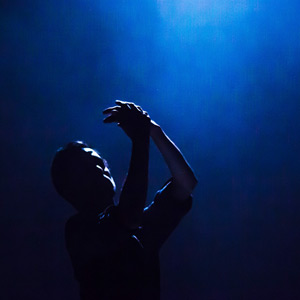
Photo: Sean Goldhtorpe
It took 21 years for him to be able to spell his name correctly. Even as a schoolboy, the artist Aakash Odedra struggled with dyslexia. He ultimately discovered dance as the mode of expression that’s right for him. In a world of written words, it gave him the secure foothold he needed. Recently, he’s been collaborating with Ars Electronica Futurelab staffers to create a dance performance entitled “Murmur” that uses visualizations, light, sound and movement to show the world through the eyes of people who have difficulty learning to read fluently and spell words. The show premieres on May 6, 2014 at DanceXchange, one of Great Britain’s foremost dance venues, in conjunction with the International Dance Festival Birmingham 2014.
It was a seminal experience for him to finally be able to write his name correctly since, in Indian numerology, the number of letters in one’s name and how it’s spelled are said to exert an especially strong influence on an individual’s identity. The 28-year-old artist discovered the perfect link between the two in Kathak, the Indian dance style on which his performance is based. “Murmur” was conceived for a performance space measuring at least 8 m2, and for the use of props and technical equipment that can be set up quickly.

Photo: Kristefan Minski
Collaboration with the Ars Electronica Futurelab began in the spring of 2013. The project got a boost in the form of a Sky Arts Futures Fund 2013 grant awarded by a British pay TV provider. A rave review in the British daily The Guardian, which called Aakash Odedra “a dancer to follow,” means that the premiere of “Murmur” is being awaited with especially great expectations. In April 2013, we interviewed him and his choreographer, Lewis Major, during their initial rehearsals at the Ars Electronica Futurelab’s studio. Their assessment of the situation at the time: “We have a forest of ideas and have to wiggle it down to a toothpick.” Now, a year later, they’re back at the Futurelab, and we took advantage of this opportunity just prior to the premiere to get the advance buzz about “Murmur” right from the insiders.
Have you already found the toothpick?
Lewis Major: I guess the status is still finding additional ideas. We had to pick a few trees and from those trees you go a little down to a toothpick. I guess, to stick with the analogy, we have got the trees and now it’s finding the toothpick. That is what we were working on three weeks ago. We had another week when the Futurelab guys came to Britain.
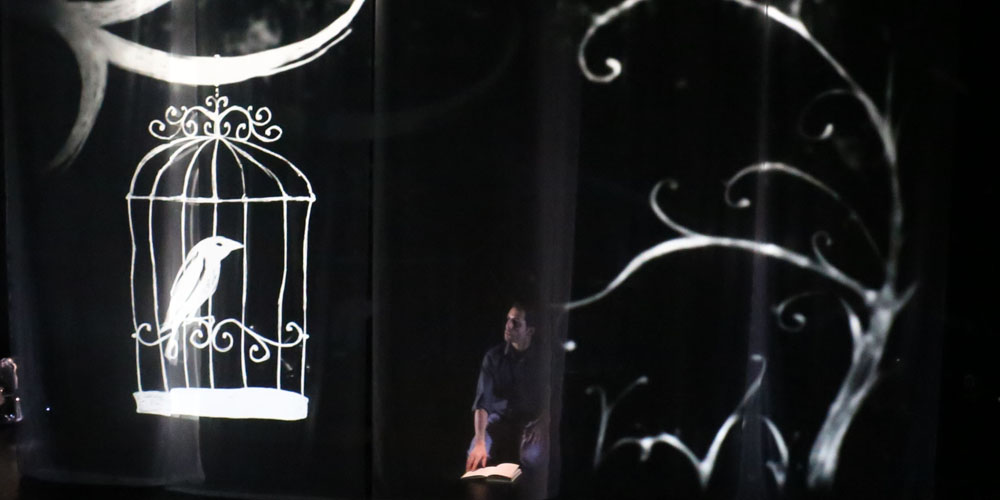
Photo: Kristefan Minski
„Murmur“ is the title of your dance performance, which refers to Murmuration…
Aakash Odedra: Murmuration literally means when a flock of birds come together. They create a swarm. And the swarm changes the shape and size. What we have found in our research is, when you look at an object optically it’s transferred in your brain and the idea of the image starts to change. So this changing of reality, this capacity to be able to change objects, is what we want to also explore as well. Murmur basically is this idea of this flock, but the flow becomes very singular and then it divides again. How is it possible that one starling which is very intelligent as an individual then flies into a mass and then the dynamic of this one bird changes the mass? Basically it is this experience of dyslexia…
Lewis Major: Dyslexia was a starting point but this is from the very beginning what we’ve wanna make this about. In essence it’s the experience with dyslexia. The piece become the story of the individual finding its way through the world and learning to deal as with the way they see the world.
Aakash Odedra: Also, the common notion of dyslexia is even subconsciously challenged. Through research we found out that the speed of thinking of the brain of dyslectics becomes multiplied to 400 to 2.000 times. And then it becomes difficult to keep up. There is a pathway the individual has to find. And this piece is really about finding a pathway. Generally, in life everybody has to find a pathway to whatever the success may be. But this piece starts with the idea of dyslexia but then you find pathway to create a world or an universe which becomes relatable to everyone.

Photo: Sean Goldhtorpe
Murmur connects dance with technology…
Lewis Major: Dance and technology, it’s not a completely new thing but I think the way we have come to work with Ars Electronica is perhaps a different way with approaching technology through a live performance. Because it has been such a collaborative exploration of dyslexia, the main theme of the piece. It’s not just about putting some pretty images on a dance piece. The dance is trying to say something and challenge peoples with ideas and concepts. Conceptions about dyslexia and I guess in a way in some sense dance. We are trying to use the technology to make what we say louder and make it bigger. Aakash is the only dancer and it’s a big space to fill in a lot of ways and a big bunch of ideas we are trying to explore using technology to accentuate those ideas and to extrapolate the concepts. This is the reason why we want to work with Ars Electronica Futurelab.
Aakash Odedra: If you look at technology and the computers we have, there is a system. In dance we also have a system as well. What often happens when we are using technology and dance that these systems seem to be separated. So there is technology and there is dance. But what’s important in this piece is that we want to integrate the two systems. The system of human thinking and dance, and the physicality of the body, and mechanics and the technology we have. And also to bring objects in space virtually. We live in world fully of technology and we use it all the time. Sometimes it’s also a virtual world we create which becomes sometimes one dimensional. But just to be able to enter into this world, to bring these two elements together, and to create this three dimensional universe that can be relatable to people. That is something we are trying to achieve with this project.
Lewis Major: The idea of the reality that we live in and also the idea of this surreal universe we live inside our head, this I think is a very good point: Technology can add this surreal element.
Aakash Odedra: Technology can give you an insight into the mind, not what’s happening in the mind exactly but it just allows you to create a window of imagination. Which is what we are trying to do with this piece: To allow a person also enter the world of imagination through technology.
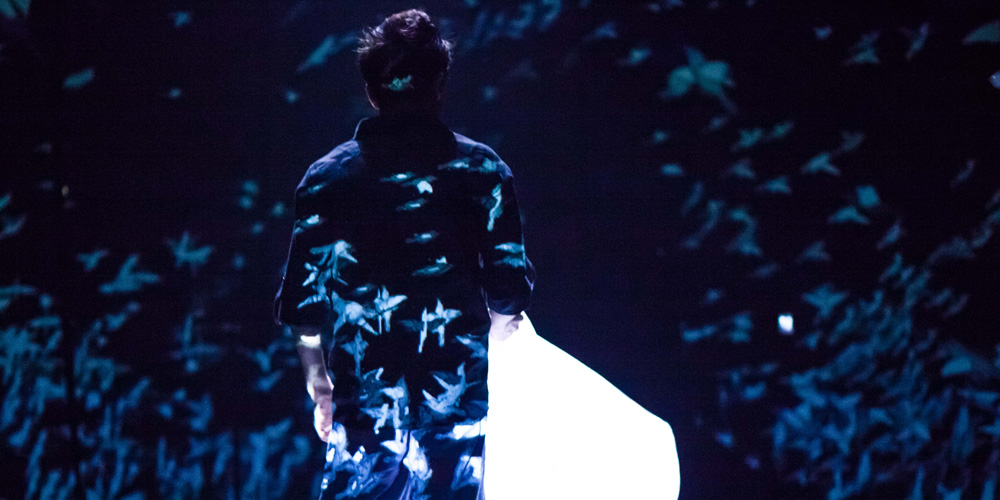
Photo: Sean Goldhtorpe
Is it difficult for you as dancer to act in this virtuality?
Aakash Odedra: I think it’s also a process of discovery for all of us. Because just as much it can be difficult to dance… There not just me at the stage, there is a relationship of Lewis who is looking something from the outside, there is a relationship with the technology, to try to combine it and bring it together and trying to find a balance of all the energies on stages. This is very challenging and a kind of journey to try to find the right balance or what works. We still trying to find, like Lewis said, trees and the toothpick from the trees.
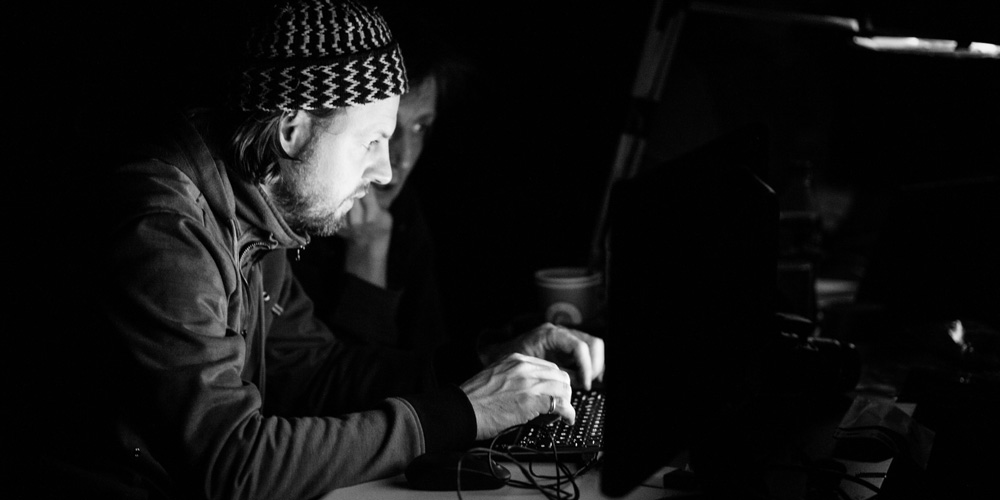
Photo: Sean Goldhtorpe
How is the Ars Electronica Futurelab involved in this project?
Lewis Major: In a very broad perspective. We’ve all profit in separate ways, I guess, but all heading towards a common goal. It hasn’t just being about programming, and lights and projection and mapping. It’s been asking questions about what it means to have this experience. We’ve given our opinions on things and really built this from the ground up together. Just in different ways. I ask Aakash to do things with his body, and so can they. A pleasant experience.
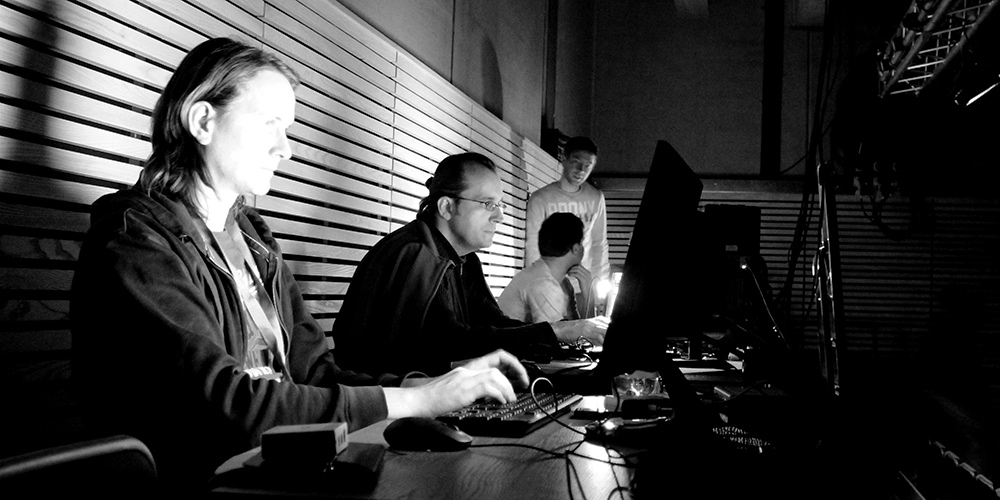
Photo: Sean Goldhtorpe
Aakash Odedra: It’s almost like tennis. You give an idea, they hit back and it becomes a snowball. This gets bigger which is interesting. Because just as much as our involvement artistically there is an equal involvement from their behalf as well. I mean just the attitude everyone went in in the beginning: We never say no to any idea never mind how ridiculous it is. We gave some very ambitious ideas and if this was not possible they helped us to find a solution. They become the path makers and helping us to shape the branches in which direction we want to grow. We were all on the same page. If we look at an image of something, we can all agree or disagree together, pretty much about the same thing, whether it works or not, which is phenomenal.
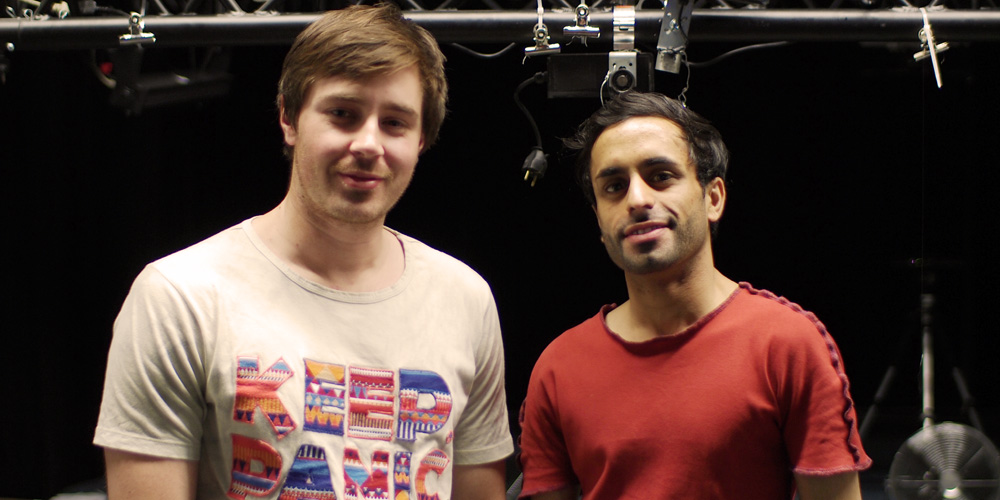
Lewis Major (left) und Aakash Odedra (right), photo: Martin Hieslmair
Will your project have any end?
Aakash Odedra: It’s changing all the time but eventually we will get back again. We think the piece has a potential.
Lewis Major: There is a possibility to come back and maybe to have a party and also a refining of everything and let us spend a bit more time here in the lab. We could still develop more, continuing the discussion and see where the piece does end up. I think the final performance is not the end of the project.
Aakash Odedra: For Lewis and myself I think it’s like become a family. Even if we will not work we have to come back. In fact we won’t give the project an end. We just keep it as a question mark. We always have to come back, we always have to improve it, and always growing. We find this place very inspiring, the people very inspiring. They allow our artistic imagination to grow further than you would imagine.
